Introduction
In an increasingly digital landscape, the significance of a well-defined IT infrastructure strategy cannot be overstated. As organizations strive to align their technological resources with overarching business objectives, they face the dual challenge of managing current demands while preparing for future growth.
This article delves into the essential components of an effective IT infrastructure strategy, emphasizing the importance of:
- Thorough assessment
- Stakeholder engagement
- Continuous improvement
With the rise of cyber threats and the rapid evolution of technology, organizations must adopt a proactive approach to fortify their IT frameworks, ensuring they remain resilient and innovative.
By exploring key metrics, alignment techniques, and the role of emerging technologies, this discussion aims to equip businesses with the insights necessary to transform their IT infrastructure into a strategic asset that drives success in the years to come.
Understanding IT Infrastructure Strategy
A technology framework acts as a thorough plan for the implementation and administration of technology assets in line with a company's overall goals. This approach includes essential elements, such as hardware, software, networks, and services, allowing companies to enhance IT investments and improve operational efficiency while promoting innovation. To commence the creation of an effective IT framework, it is crucial to first carry out a comprehensive evaluation of the existing system.
This entails understanding the diverse needs of stakeholders, identifying existing gaps, and evaluating how these elements contribute to operational goals. In 2024, as entities encounter rising cyber threats—over 2,200 cyber attacks are reported daily—it is crucial to guarantee that infrastructure plans are strong and flexible. I&O teams play a crucial role in assisting entities in achieving their top-level objectives during this challenging landscape.
This foundational knowledge is crucial as it guides following actions in developing a plan that not only tackles present challenges but also prepares entities for future success. CrowdStrike emphasizes the importance of proactive measures through platforms like Falcon, which monitor device activities and automatically respond to potential threats. This integrated security approach illustrates how entities can enhance their IT strategy infrastructure.
Additionally, effective data management is essential for ensuring data quality, accessibility, and security, empowering entities to leverage their data effectively. As highlighted in recent case studies, entities can unlock the full potential of their data through improved management practices, ultimately driving innovation and operational excellence.
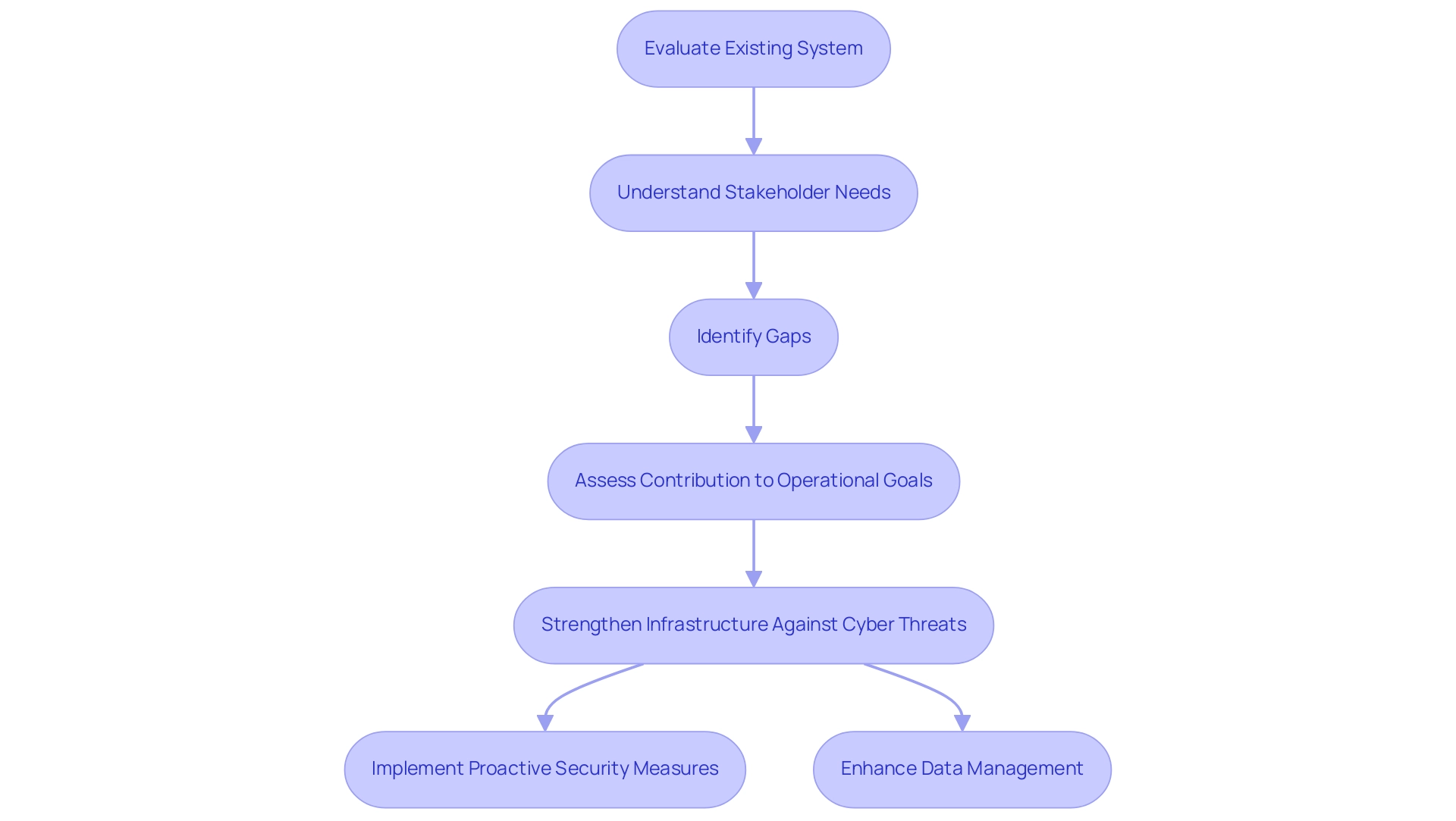
Key Components of an Effective IT Infrastructure
A robust IT infrastructure is foundational to any organization’s success, encompassing several critical components that require thorough evaluation:
-
Hardware: Essential elements such as servers, workstations, and networking equipment must be rigorously assessed for both performance and scalability. This evaluation is vital, especially given the statistic that at least 10% of IT spending does not align with business goals, indicating that hardware choices can significantly affect overall efficiency and resource allocation.
-
Software: Existing applications should be scrutinized for their efficiency and compatibility with emerging technologies. As entities evolve, ensuring that software systems can integrate seamlessly with new solutions is paramount for maintaining operational fluidity. This is crucial in light of the statistic that Applause integrated CloudZero and saw their cloud spend drop by 23%, showcasing the financial benefits of effective software evaluation.
-
Network: A comprehensive analysis of your network architecture is necessary to confirm it meets both current demands and anticipates future growth. This progressive strategy can prevent bottlenecks and ensure that your systems support business agility.
-
Security: Implementing robust security measures is critical for safeguarding data and adhering to regulations. Conducting a thorough inventory of your security protocols helps identify vulnerabilities that, if addressed proactively, can mitigate risks effectively.
By meticulously evaluating these components, organizations can uncover strengths and weaknesses within their IT systems. This strategic insight not only informs planning but also aligns the IT strategy infrastructure with broader business objectives. As demonstrated by case studies like Drift, which successfully lowered its yearly cloud expenses by $2.4 million through effective cost management strategies, the significance of IT systems cannot be overstated.
As Cody Slingerland, a FinOps certified practitioner, emphasizes, "The role of IT systems in supporting business goals is critical; efficient management is essential for maximizing returns on investment." This highlights the need for continuous evaluation and alignment of IT components with organizational goals.
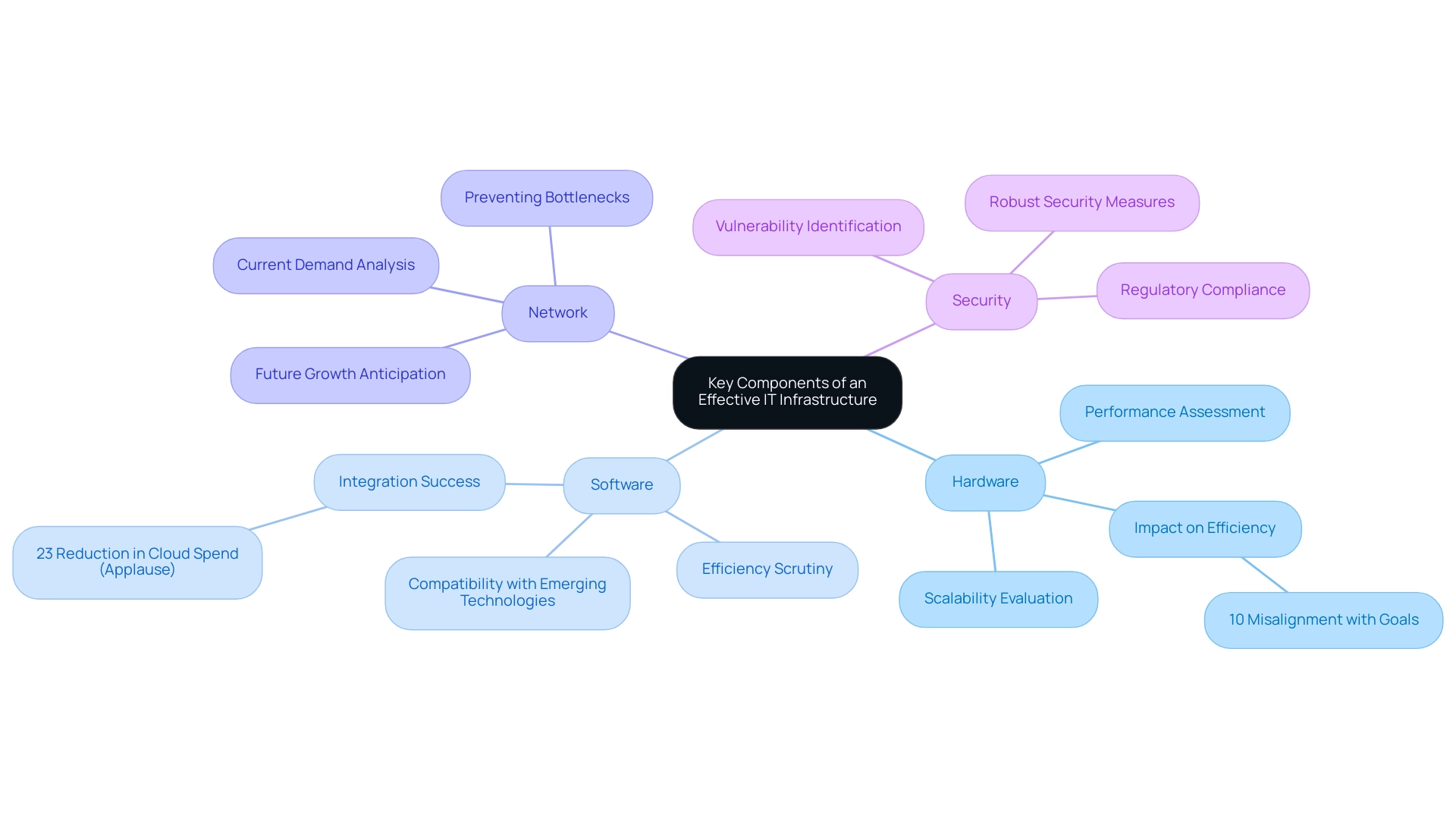
Aligning IT Infrastructure with Business Objectives
To effectively align your business objectives with the IT strategy infrastructure, it is essential to engage with key stakeholders to gain a thorough understanding of their needs and expectations. Starting this dialogue establishes a foundation for collaboration and ensures that IT initiatives are closely aligned with the strategic direction of the entity. Research conducted on over 300 companies undergoing data and analytics transformations indicates that entities that prioritize IT alignment with business objectives achieve significantly better performance outcomes.
Conducting a SWOT analysis—evaluating Strengths, Weaknesses, Opportunities, and Threats—provides a clear framework to assess how IT can effectively support and advance business goals. This analytical approach allows organizations to prioritize technology initiatives based on their potential impact, ensuring that resources are allocated efficiently. Furthermore, maintaining regular communication with leadership is crucial.
This engagement enables the modification of plans in response to changing business goals, thus ensuring that the IT strategy infrastructure remains a crucial strategic resource. As highlighted in a case study on resistance to legacy application retirement, many business leaders are hesitant to replace outdated systems due to concerns about reliability, which can hinder necessary upgrades and alignment efforts. Additionally, the rise of emerging technologies like AI and ML is set to revolutionize alignment approaches, enabling IT leaders to leverage these tools for enhanced effectiveness.
As Gary Middleton, Vice President of Networking for NTT Data, aptly noted,
Hopefully, investments in AI will enable IT leaders to simultaneously upgrade much of the IT infrastructure that models will be deployed on in the month ahead.
This underscores the need for proactive engagement and adaptability in IT strategy infrastructure to effectively leverage emerging technologies.
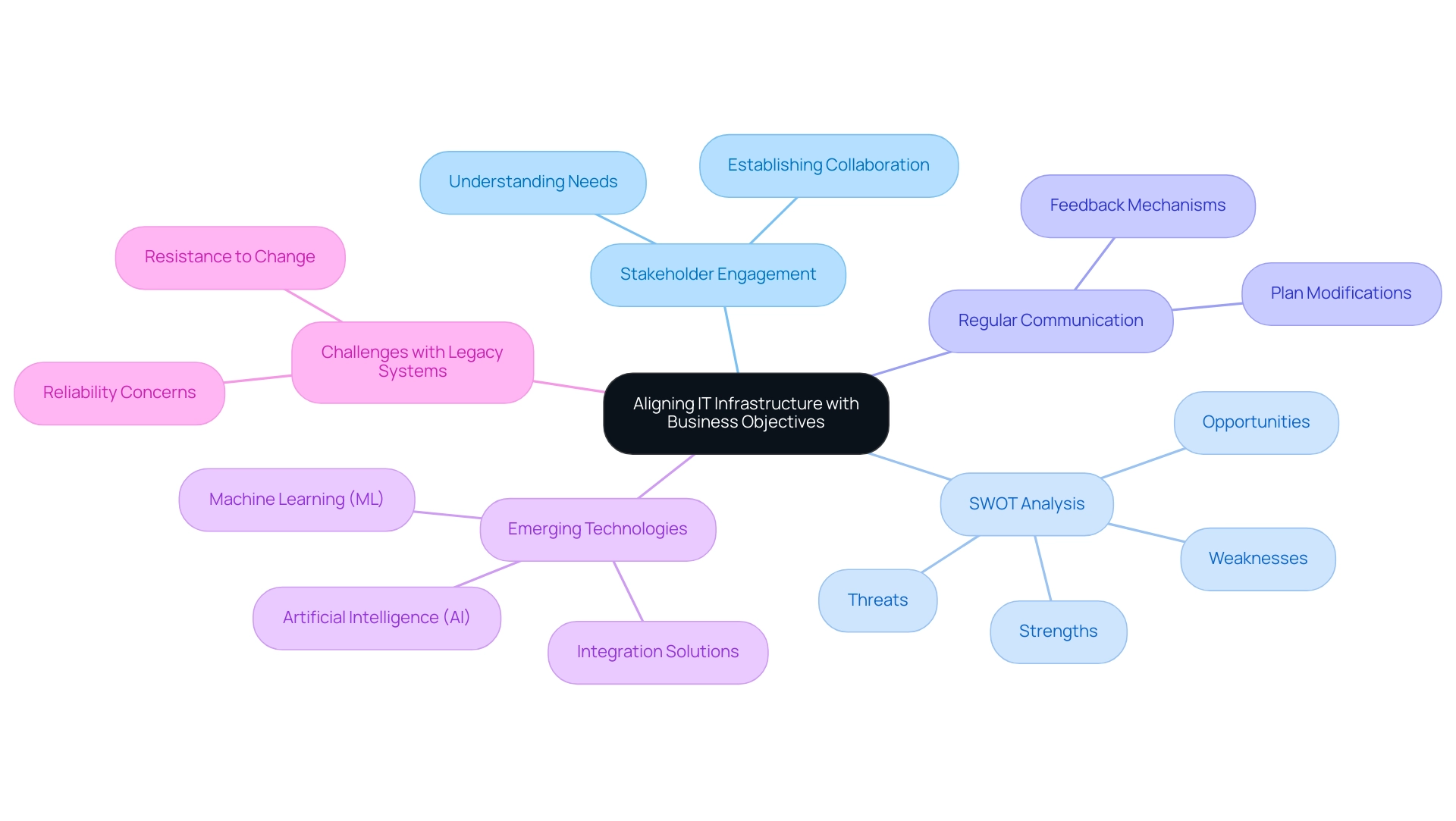
Establishing Measurable Targets and KPIs
Establishing specific, measurable, achievable, relevant, and time-bound (SMART) targets is critical for driving successful IT initiatives. Key performance indicators (KPIs) such as:
- System uptime
- IT support response times
- User satisfaction ratings
- Cost savings from IT improvements
serve as foundational metrics for assessing IT performance. For instance, monitoring response times for IT support can provide insight into operational efficiency and user satisfaction, both of which are essential for maintaining a robust IT infrastructure.
Furthermore, the Mean Time to Recover (MTTR) statistic provides a quantitative assessment of how swiftly organizations can bounce back from IT incidents, highlighting the significance of efficient recovery approaches. Utilizing tools such as dashboards to visualize these data points allows IT teams to monitor progress over time effectively. A case study of the NinjaOne Platform for IT Management illustrates this point well, as it provides a centralized solution that simplifies IT operations, enhances visibility, and automates time-consuming tasks, ultimately improving team effectiveness.
Regularly reviewing these metrics not only helps determine if the IT strategy infrastructure is fulfilling its objectives but also allows for timely adjustments to ensure alignment with broader business goals. As highlighted by industry professionals, by aligning these KPIs with strategic goals and utilizing them as guiding tools, companies can enhance resilience, optimize outcomes, and direct their systems toward success in 2024 and beyond. Moreover, taking into account the Total Cost of Investment (TCO) is vital for evaluating the cost-effectiveness of IT assets throughout their lifecycle, offering a thorough understanding of IT effectiveness metrics.
This proactive method to evaluation is essential as organizations navigate the changing environment of IT support.
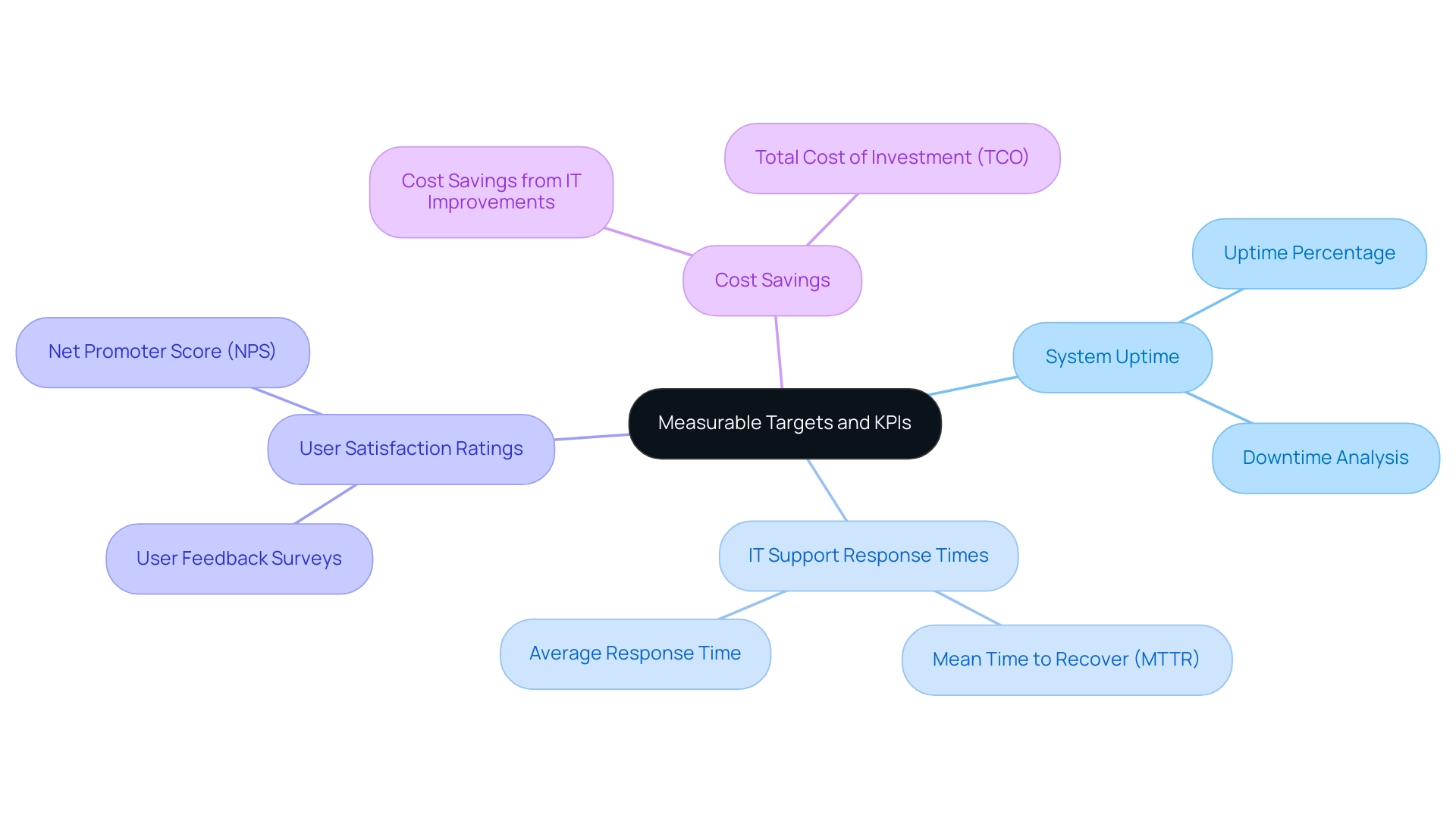
Periodic Reviews and Adjustments for Continuous Improvement
To ensure your IT strategy infrastructure remains robust and aligned with organizational goals, it is advisable to establish a regular review schedule, ideally every six months. During these reviews, it is essential to evaluate performance against key performance indicators (KPIs) while systematically collecting feedback from stakeholders. This feedback is crucial, as research indicates that entities with effective feedback mechanisms see a notable reduction in turnover rates, with improvements of up to 14.9%.
Moreover, employees who are 'thriving' are four times more likely to be engaged with a firm that understands their abilities and interests, underscoring the significance of aligning feedback with employee needs. Analyzing emerging technologies during these reviews can unveil opportunities for enhancement and innovation. As Sam Altman aptly states,
The future of business lies in anticipation, not retrospection.
Thus, being proactive in adopting new solutions can significantly elevate your system's effectiveness. Furthermore, fostering a culture of continuous improvement within your IT team is vital. Embracing this mindset not only supports innovation but also positions your organization to adapt swiftly to changing industry demands.
For instance, the case study titled 'Role of Employee Feedback in Innovation' illustrates how encouraging regular and constructive feedback can tap into employees' creativity, fostering an environment conducive to innovation. Additionally, the case study 'Improving Company Culture through Employee Feedback Data' demonstrates how analyzing feedback data can identify areas for improvement, promoting a more inclusive and responsive environment. By consistently modifying your strategy based on insights obtained from evaluations, you ensure that your IT strategy infrastructure remains not only relevant but also a crucial factor in maintaining competitive advantage.
It's also worth noting that only 2% of employers feel their performance management approach provides outstanding value, highlighting the necessity for effective performance management and the potential gaps in current practices.
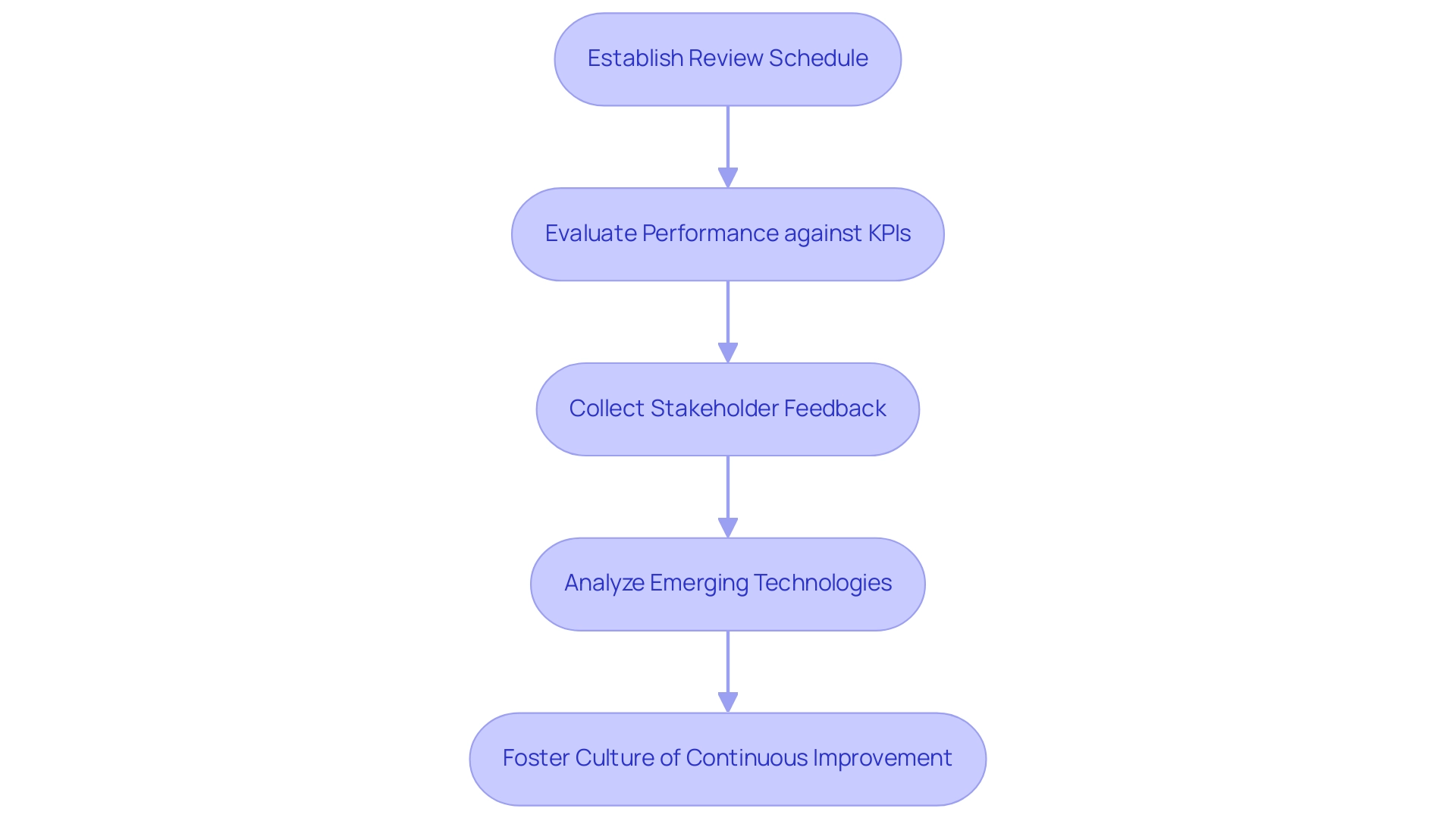
Conclusion
A well-defined IT infrastructure strategy is crucial for organizations aiming to thrive in a rapidly evolving digital landscape. By conducting thorough assessments, engaging stakeholders, and committing to continuous improvement, businesses can align their IT resources with strategic objectives, ensuring operational efficiency and fostering innovation. The importance of evaluating core components such as hardware, software, networks, and security cannot be understated; these elements form the backbone of a resilient IT framework capable of supporting current demands and future growth.
Moreover, establishing measurable targets and key performance indicators (KPIs) is essential for tracking the effectiveness of IT initiatives. By regularly reviewing these metrics and adjusting strategies accordingly, organizations can remain agile and responsive to changing business needs. The role of emerging technologies further enhances this adaptability, allowing IT leaders to leverage advancements such as AI and machine learning for improved alignment with organizational goals.
Ultimately, a proactive approach to IT infrastructure management not only mitigates risks associated with cyber threats but also positions organizations to capitalize on opportunities for innovation. By fostering a culture of continuous improvement and prioritizing stakeholder feedback, businesses can transform their IT infrastructure into a strategic asset that drives long-term success in an increasingly competitive environment. The path forward is clear: organizations must embrace these principles to ensure their IT frameworks not only support but also propel their overarching business objectives.




